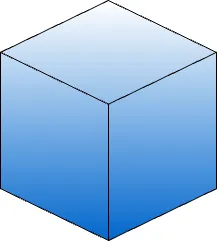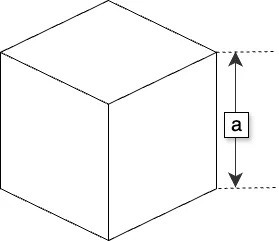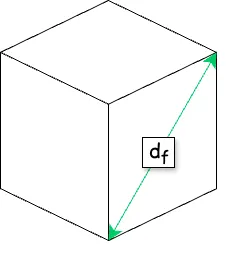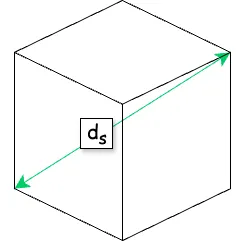Volume of a Cube Formula
The volume of a cube is the amount of space it occupies, which is determined by its three equal dimensions. A cube has six identical square faces, making it possible to calculate its volume in several ways: using the side length, the face diagonal, or the space diagonal.

Below are the formulas for calculating the volume of a cube, with detailed explanations and examples for each method.
Formulas for the Volume of a Cube
Using Side Length:
If the side length \( a \) of the cube is known,

The volume \( V \) can be calculated with the formula:
\( V = a^3 \)
Using Face Diagonal:
If the length of the face diagonal \( d_f \) is known,

The volume \( V \) can be calculated using the following formula:
\( V = \left(\dfrac{d_f}{\sqrt{2}}\right)^3 \)
Using Space Diagonal:
If the length of the space diagonal \( d_s \) is known,

The volume \( V \) can be calculated as:
\( V = \left(\dfrac{d_s}{\sqrt{3}}\right)^3 \)
In these formulas:
- \( a \) is the length of any side of the cube
- \( d_f \) is the face diagonal, or the diagonal across one of the cube’s faces, where \( d_f = a\sqrt{2} \)
- \( d_s \) is the space diagonal, or the longest diagonal across the cube’s volume, where \( d_s = a\sqrt{3} \)
Detailed Explanation of Each Formula
1 Formula for Volume Using Side Length
The formula \( V = a^3 \) calculates the volume by cubing the length of one side. This method is the most straightforward, as it only requires knowing the side length of the cube. Since all sides are equal, multiplying the side length by itself three times gives the total volume.

Example 1: Calculating Volume with Given Side Length
Problem: Find the volume of a cube with a side length of \( a = 4 \, \text{cm} \).
Solution:
- Write down the formula: \( V = a^3 \).
- Substitute \( a = 4 \): \( V = 4^3 \).
- Calculate the cube of the side length: \( V = 64 \, \text{cm}^3 \).
The volume of the cube is \( 64 \, \text{cm}^3 \).
2 Formula for Volume Using Face Diagonal
The formula \( V = \left(\dfrac{d_f}{\sqrt{2}}\right)^3 \) calculates the volume by using the face diagonal. This formula is derived from the relationship between the face diagonal \( d_f \) and the side length, where \( d_f = a\sqrt{2} \). By rearranging this, we can express \( a \) in terms of \( d_f \) and calculate the volume.

Example 2: Calculating Volume with Given Face Diagonal
Problem: A cube has a face diagonal of \( d_f = 5 \, \text{cm} \). Find its volume.
Solution:
- Write down the formula: \( V = \left(\dfrac{d_f}{\sqrt{2}}\right)^3 \).
- Substitute \( d_f = 5 \): \( V = \left(\dfrac{5}{\sqrt{2}}\right)^3 \).
- Simplify: \( V = \left(\dfrac{5}{1.414}\right)^3 \approx (3.536)^3 \).
- Calculate the cube: \( V \approx 44.2 \, \text{cm}^3 \).
The volume of the cube is approximately \( 44.2 \, \text{cm}^3 \).
3 Formula for Volume Using Space Diagonal
The formula \( V = \left(\dfrac{d_s}{\sqrt{3}}\right)^3 \) calculates the volume by using the space diagonal, which is the longest diagonal in a cube, running from one corner to the opposite corner. Since the space diagonal \( d_s \) relates to the side length as \( d_s = a\sqrt{3} \), we can rearrange to find \( a \) in terms of \( d_s \) and then calculate the volume.

Example 3: Calculating Volume with Given Space Diagonal
Problem: A cube has a space diagonal of \( d_s = 6 \, \text{cm} \). Find its volume.
Solution:
- Write down the formula: \( V = \left(\dfrac{d_s}{\sqrt{3}}\right)^3 \).
- Substitute \( d_s = 6 \): \( V = \left(\dfrac{6}{\sqrt{3}}\right)^3 \).
- Simplify: \( V = \left(\dfrac{6}{1.732}\right)^3 \approx (3.464)^3 \).
- Calculate the cube: \( V \approx 41.6 \, \text{cm}^3 \).
The volume of the cube is approximately \( 41.6 \, \text{cm}^3 \).
These examples show how to calculate the volume of a cube using different known measurements, whether it’s the side length, face diagonal, or space diagonal.
